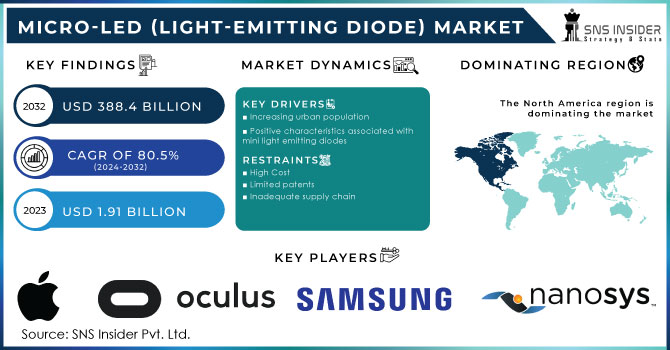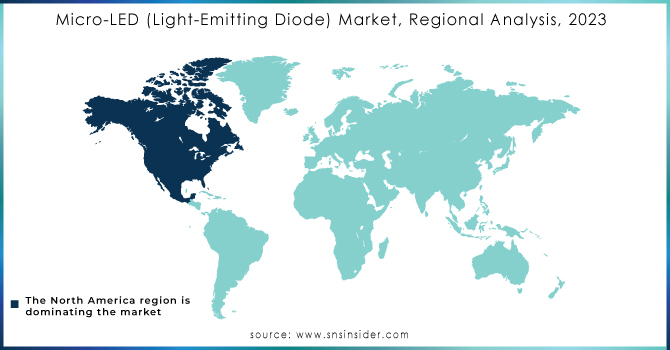Micro-LED (Light-Emitting Diode) Market Size:

Get more information on Micro-LED (Light-Emitting Diode) Market - Request Sample Report
The Micro-LED (Light-Emitting Diode) Market Size was valued at USD 1.91 billion in 2023 and is expected to reach USD 388.4 billion by 2032 and grow at a CAGR of 80.5% over the forecast period 2024-2032.
The light-emitting diode is denoted by the LED. When electrical energy passes through a semiconductor device, it emits light. LEDs are considered cutting-edge technology and are employed in energy-efficient lighting. When compared to halogen or incandescent bulbs, LED lighting helps to save money by reducing energy consumption by roughly 80%. They also include lifespan, high light quality, and endurance, making them useful in industries and living spaces such as modular lighting, work illumination, under-cabinet lighting, refrigerated case lighting, and recessed lamps.
A micro-light emitting diode (LED) display is a screen with an array of small LEDs of various colours. It is made of gallium nitride, which allows the scattering of red, green, and blue (RGB) LED lights to shine brighter for a longer amount of time. It's brighter, has higher wavelength uniformity, very high definition UHD picture quality and more saturation of colors. It In addition, they contribute to lower energy consumption, a longer lifespan and improved contrast and reaction times. Micro LED (Light Emitting Diode) is an emerging display technology that utilizes microscopic LED chips to create individual pixels. Micro LED displays do not require a backlight because each pixel emits its own light, which is different from traditional LEDs. This allows for better contrast ratios, higher brightness levels, and improved energy efficiency. The advantages of a wide colour range, rapid response times and the ability to achieve large resolutions are also available in mini-LED displays.
Micro-LED (Light-Emitting Diode) Market Dynamics:
KEY DRIVERS:
-
Increasing urban population
-
Positive characteristics associated with mini light emitting diodes
Consumer electronics mini-LED diode provides a wide range of advantages, such as excellent readability, very narrow spectrum light. Compared to other sources of illumination, energy efficiency, low operating costs and a long life. These are expected to reduce losses of electronic power and increase them. market usage of competently used diode light emitting diode (LED) displays.
RESTRAINTS:
-
High Cost
-
Limited patents
-
Inadequate supply chain
The growth of the market is hindered by the high cost of mini-LED diode. The high cost will create further affordability problems, which are expected to persist market growth. Also, the challenge for the consumer electronics mini is the large number of ICs required to operate the mini diode light emitting diode LED Over the forecast period, the market for diode light emitting diode LED is expected to grow.
OPPORTUNITIES:
-
Growing demand for Augmented and virtual reality technology
Augmented and virtual reality technology is increasing in demand. For AR headsets, micro-LED displays are ideal. and other devices because they offer high resolution displays with low power consumption, which is essential for ensuring a high-resolution quality experience. The Micro LED market also has an opportunity due to the increasing demand for Flexible Displays. Micro-LED Displays can be made to be very thin and flexible, which means that they are perfect for use in wearables or curved displays.
-
Expansion in Consumer Electronics Sector
CHALLENGES:
-
Significant initial costs and complexity in the manufacture
-
Problems in mass production and integration of technologies
IMPACT OF RUSSIAN UKRAINE WAR
According to the European Commission, it will provide up to 30 million light emitting diode bulbs after Ukrainian President Volodymyr Zelenskiy claims that 50 million of these bulbs would greatly reduce There's a lack of electricity in the country. The energy use of LED bulbs is approximately 75% less than the traditional bulb and can last up to 10 times longer. "I hope we'll be followed by other partners," European Commission President Ursula von der Leyen said conference. Russia Nas been pounding Ukraine's energy infrastructure since October, destroying or Gamaging Nal OF It. Economy Minister Yulia Svyridenko of Ukraine stated that the people will be able to avail themselves of a scheme for exchanging light bulbs at no cost be introduced soon, ultimately helping to reduce power consumption by 7-10% at peak times. Ukraine's allies promised more than a billion dollars in aid, but they also vowed to provide it. energy-efficient LED bulbs to ease power shortfalls and help Ukraine get through freezing winter months As Russia squeezes out infrastructure in the country. They made the pledge at a global meeting, hosted by France, to discuss what could be offered between to keep water, food, energy, health and transport in Ukraine's typically cold winter period between now and March winter.
IMPACT OF ECONOMIC DOWNTURN:
Industries start to feel the impact of a slowdown in economic activity. Prices and availability of products are expected to be negatively affected by the economic downturn. In the DBMR market insight reports and intelligence services they shall take account of these considerations. In that way, our clients can typically maintain a lead over their competitors project their sales and revenues, as well as estimated the expenditure related to profits and losses. The HID bulbs are used in most lighting applications, although some do not use them Due to the advantages of light emitting diodes, applications are switching from HIDs to LEDs. The LED technology has been dominant in the Outdoor Lighting industry since about 2010; LEDs were not enough in terms of illumination on the outside. The study carried out in 2014 has come to a conclusion that colour temperature and accuracy of LED lights was easily recognized by consumers, with preference for LEDs with natural colour temperatures. A complete technoeconomic analysis, which took into account the company and national situation The economic benefits in terms of the longer service life of LED bulbs Up to 100,000 hours of work. and its low power consumption compared with HPS was carried out. Only 400 W HPS lighting cases may therefore be covered by this analysis.
Micro-LED (Light-Emitting Diode) Market Segment Overview:
By Panel Size
Micro display, small & medium sized panels, and Others are the segments of the market based on type. and large panels. The market was dominated by small and medium sized panels, accounting for 35% of sales. revenue (0.09 billion). The growth of the category is driven by increasing demand for smart displays in developing countries. A In addition to the others, a touchscreen device with voice assistance referred to as an "intelligent display" is employed of Things, IoT enabled household: But the fastest growing category is big panels. Compared to other product types, they have good wavelength regularity and are suitable for fine pitch board.
By Application
Smartwatches, NTE devices, televisions, heads-up displays, smartphones and tablets, monitors and laptops, and digital signage are included in the segmentation of the micro-LED display market on the basis of application. The most profitable category was smartwatches, with 70.4% of revenue. Micro-LED constituents offer the lowest, lighter-weight alternatives to traditional LED or OLED panels in smartwatches. Nevertheless, owing to the growing investments in research and development activities as well as increasing demand for smartphones & tablets, this category is experiencing a growth faster than others.
Micro-LED (Light-Emitting Diode) Market Regional Analysis:
North America dominates the micro light emitting diode (LED) market due to the rise in the penetration of near-to-eye (NTE) devices, television, smartphone and tablet, head-up display (HUD), laptop, and monitor. In addition, the growth of the micro light emitting diode LED market in this region over the forecast period is also expected to be stimulated by growing adoption of smartwatches. The Asia Pacific region is expected to see a substantial increase in microlight emission diodes. Due to the presence of major LED Foundries, display panel manufacturers and their customers in this market. In addition, the most recent technological progress in the coming years, micro-LED is also expected to drive growth of the region's market for light emitting diodes.
In 2022, the Asia Pacific market will be leading in revenues. The main driver of this region's market revenue growth is rapid technical improvements in the electronics sector. Continuously expanding smartphone penetration and major technical developments in the technology business are key elements driving this region’s market commercial expansion. Moreover, the fact that there are several producers in this region makes it economically feasible to switch from standard panels.

Get Customized Report as per your Business Requirement - Request For Customized Report
KEY PLAYERS:
The top players in the Micro-LED (Light-Emitting Diode) Market are examined in this analysis, including their company strategy, financial status, and future products. Some key participants include: Apple, Oculus VR, Sony, Samsung Electronics, X-Celeprint, Nanosys, Jade bird display, Aledia, mikro mesa, verlase technologies, allos semiconductors and Other Players.
| Report Attributes | Details |
|---|---|
| Market Size in 2023 | US$ 1.91 Billion |
| Market Size by 2032 | US$ 388.4 Billion |
| CAGR | CAGR of 80.5% From 2024 to 2032 |
| Base Year | 2023 |
| Forecast Period | 2024-2032 |
| Historical Data | 2020-2022 |
| Report Scope & Coverage | Market Size, Segments Analysis, Competitive Landscape, Regional Analysis, DROC & SWOT Analysis, Forecast Outlook |
| Key Segments | • By Application (Display, Lighting) • By Industry (Consumer Electronics, Advertising, Automotive, Aerospace And Defense, Others) • By Panel Size (Micro Display, Small And Medium-Sized Panel, Large Panel) |
| Regional Analysis/Coverage | North America (US, Canada, Mexico), Europe (Eastern Europe [Poland, Romania, Hungary, Turkey, Rest of Eastern Europe] Western Europe] Germany, France, UK, Italy, Spain, Netherlands, Switzerland, Austria, Rest of Western Europe]), Asia Pacific (China, India, Japan, South Korea, Vietnam, Singapore, Australia, Rest of Asia Pacific), Middle East & Africa (Middle East [UAE, Egypt, Saudi Arabia, Qatar, Rest of Middle East], Africa [Nigeria, South Africa, Rest of Africa], Latin America (Brazil, Argentina, Colombia, Rest of Latin America) |
| Company Profiles | Apple, Oculus VR, Sony, Samsung Electronics, X-Celeprint, Nanosys, Jade bird display, Aledia, mikro mesa, verlase technologies, allos semiconductors and Other Players. |
| Key Drivers | • Brighter and power-efficient display • Increasing urban population |
| Restraints | • Limited patents • Inadequate supply chain |

